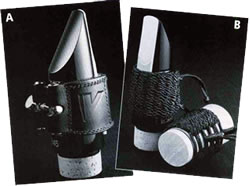Review by Andrew Roberts, originally published in CASS magazine, Spring 2005
As I am known to all and sundry as Andy Gadget, it should be no surprise to hear that I have always had a penchant for trying and owning new ligatures.
Many of my colleagues are sceptical as to what the advantages and disadvantages that the various models supposedly have. In my experience, the effect can be quite dramatic, usually in the change in response or the feel to the player. Occasionally the sound is affected enough for others to notice a change.
My long-suffering wife, a self-confessed “clarinet widow”, is often drafted in for an objective opinion, and has commented favourably on the improvement, for example, that the Vandoren Optimum made. I have been using an Optimum almost exclusively on all of my instruments for several years now, and noted that many of my colleagues (including previous sceptics) have become Optimum converts, as it seems to be the most popular choice at present.
I have experimented with the different plates and again most players seem to end up using the same number 1 plate. Incidentally, there is a marked improvement if the plate is put on with the “no. 1” on the left hand side.
 After a long preamble the stage is now set for the arrival of a parcel from Kerry Long of the latest Vandoren offerings, the Leather and the German String Type Klassik Ligature for my assessment.
After a long preamble the stage is now set for the arrival of a parcel from Kerry Long of the latest Vandoren offerings, the Leather and the German String Type Klassik Ligature for my assessment.
Most of my students have played them, allowing me to give an objective opinion. The leather ligatures (see photo A) are supplied with three plates; one is metal (similar to the no.1 plate of the Optimum) and two leather inserts with one harder than the other.
It came as no surprise that the metal plate was nearly always the first choice. It allows for firm support without damping the natural vibrations of the reed. The result is sound that is slightly more cushioned than the Optimum. There are perhaps fewer high harmonics in the sound, but articulation and dynamic ranges are excellent. In my tests, the other inserts are less successful. They do offer a further reduction of the higher harmonics and would suit a mouthpiece/reed setup which is a bit too bright. They do not offer the same clarity of articulation but some people will find them an interesting alternative.
Only time will tell if the leather in the ligature will stretch enough to make the adjusting posts meet. There is a decent gap between them, unlike some previous material type ligatures.
String ligatures would have been used on some of the very earliest clarinets, so it is far from a new concept. This new version (see photo B) does have a marked advantage over all its predecessors as you can tighten it quite easily. There is a gap between the very tightly wound sides which are linked, rather like a corset, with sliding adjusters. This has to be a two-handed operation, with the clarinet resting on the chair.
Having several string type models in my collection already, I was not surprised that it worked well, even on the E flat clarinet, a first to my knowledge.
The more I used it, the more I liked it. The response is much better than anything else I have tried to date. The sound is immediately fuller and the reed selection has been far easier. I have now given several performances using it and hope to continue with it in the future. However, there is a practical downside as string type ligatures hold the reed without gripping the mouthpiece too tightly. This will help prevent the mouthpiece warping (a common problem with over tightened metal designs) but it is not so good when having to change instruments quickly. It is possible to manage this safely by gripping the sides of the beak (not the ligature) and only when the mouthpiece cork is well greased.
One other small problem for me was that the supplied plastic cap managed to contact and break a rather nice reed. This isn’t a difficult thing to avoid, and is probably as a result of it being designed for a German-style mouthpiece, so possibly the more expensive leather cap version might be worth the extra money.
In conclusion, save up your pocket money and buy the German style ligature; it will provide you with hours of fun, and is worth every penny!